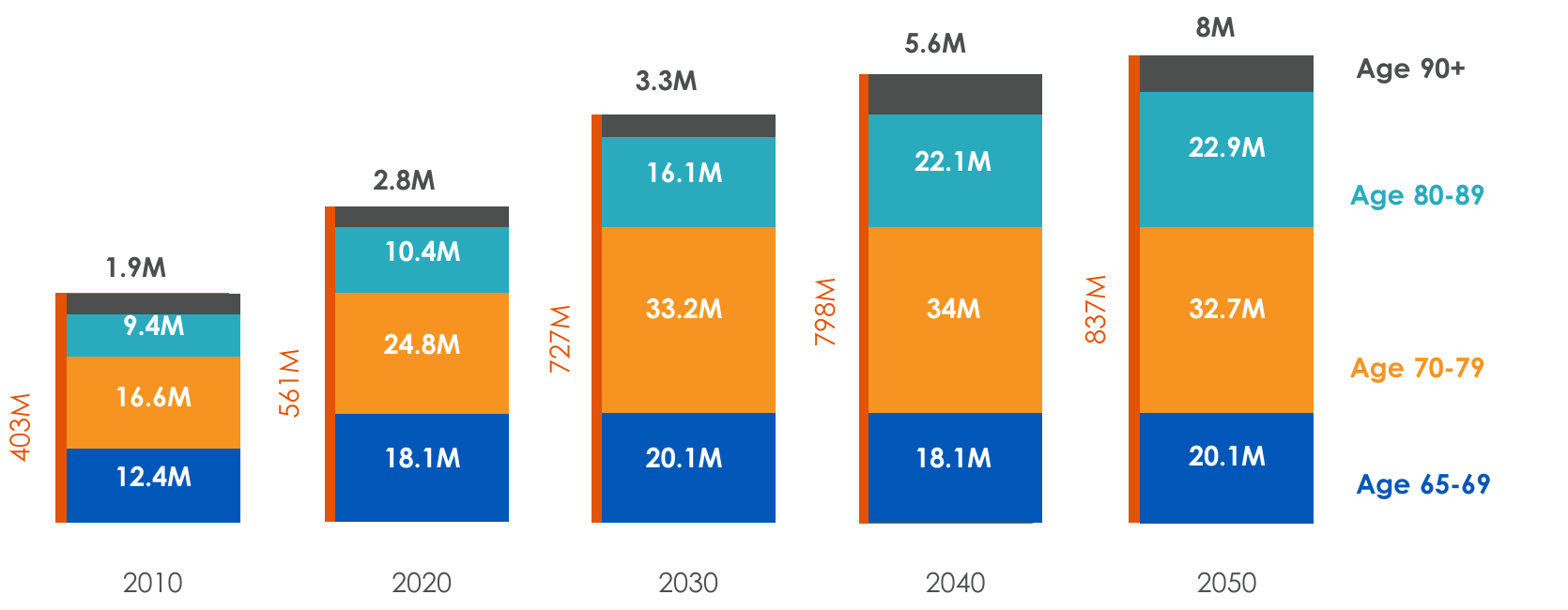Seniors are the future.
According to U.S. Census Bureau data, for the first time in our history, older adults are projected to take the population lead in less than two decades: in 2034, there will be 77 million seniors (age 65 and over) and 76.5 million children (age 18 and under). Census data currently shows that middle-aged Americans already outnumber children as well.
The rise of seniors doesn’t stop there. A Kaiser Family Foundation study shows that the number of people ages 80 and older is projected to nearly triple between 2010 and 2050 to about 31 million, while the number of people in their 90s and 100s will quadruple from 2 million to 8 million.
So what does this mean?
Challenges and concerns: the needs of an emerging generation of seniors
Baby boomers have enjoyed more birthdays than previous generations for a while now, and news headlines about the “rise of seniors” has made more appearances in the last decade. But as we move closer in years to this official demographic shift, the challenges associated with it become more pressing.
Whether you’re among the nearly 77 million seniors or you’re a senior caregiver of any age (AARP estimates one quarter of the nation’s unpaid caregivers are millennials), a number of concerns are on the horizon — or are already in motion.
Here are four challenges facing seniors in 2020:
1. Physician shortage: A growing senior population with increasing care needs requires a physician surge, but data suggests a shortage instead. Per the Association of American Medical Colleges, a shortage of up to nearly 122,000 physicians is expected by 2032, right around the time when seniors officially outnumber children. And it’s not just doctors who are in short supply for the senior population: a nurse shortage and limited availability of care services in rural settings continue to strain an already taxed system.
2. The cost of care: Nursing home and assisted living care is expensive and often not first choice of care delivery, but home health care is equally costly — and not generally covered by Medicare or Medicaid.
Many millennials are caring for grandparents at the expense of their own career and family goals. Adult children and their families are splintered by the stresses of caring for an aging parent; sibling dynamics and disagreements about care decisions are the cause of much turmoil. And the strain of long-term caregiving — for example, someone with Alzheimer’s can live with the disease for up to 20 years — and even shorter-term, high-stress caregiving (i.e. stroke recovery) is taking its toll on boomers’ health.
3. Economic disparities: Some older adults willingly work well into their 80s. Others, however, are forced to work longer into the retirement years because of financial pressures. This cost burden is often unplanned and may be the result of lost productivity due to caring for an aging parent or adult child with developmental disabilities or special needs. In some cases, their health has been compromised due to caregiving stresses or an unplanned health crisis, limiting their ability to work.
Senior hunger and poverty are huge challenges in today’s world: a 2017 study from Feeding America suggests that 5.5 million seniors don’t have access to enough nutritious foods, a number that has more than doubled since 2001 and will likely continue its upwards trend with the current senior population surge.
4. Social concerns: Every day there is more data on the grief, loneliness, and isolation of seniors and the accompanying health risks — both physical and emotional. A steady (and in some areas, sharp) increase in the rates of suicide, divorce, substance abuse, and mental health concerns among the senior population underscores just how hard these aforementioned challenges hit home. With more seniors worrying about where their next meal will come from and where they will live if they outlive their savings, the rise in rates of depression, grief, and loneliness is perhaps not surprising.
But where there are great challenges, there are greater opportunities for innovation and community, for technology and connection — and this reality offers hope and promise to our older generation and those that will follow.
New Medicare Advantage benefits expand access to vital home and community-based services, allowing more seniors to age in place. The rise of value-based care means providers are motivated by better long-term outcomes, not just better head counts.
Smart phones, tablets, and watches with a range of life-saving and quality-of-life-improving health care applications empower consumers of all ages to take control of — and be more involved in — a healthy lifestyle and wellness decisions.
Affordable technology that spans miles in milliseconds afford today’s seniors stronger relationships with grandchildren and great-grandchildren than previous generations enjoyed.
Yes, seniors today have legitimate concerns and well-founded worries. But with the many tools, technologies and human support available, they also have many reasons to navigate the new year with confidence.



